Abstract
OBJECTIVES: The questionnaire 16 (Q16) is commonly used to study prevalences of neurotoxic symptoms among workers exposed to organic solvents. It has also been recommended that exposed workers reporting more than six symptoms should be referred for further examination of possible chronic toxic encephalopathy. It would be useful to know whether symptoms reported in the questionnaire also reflect impairment of similar functions measured with objective or semiobjective methods in a formerly highly exposed group. METHODS: 135 painters and 71 carpenters answered the Q16, were interviewed about symptoms compatible with an organic brain damage, and took a battery of psychometric tests. A subsample of 52 painters and 45 carpenters were interviewed for psychiatric diagnosis according to Diagnostic and Statistical Manual for Mental Disorders, 3rd version (DSM III) and their vibration thresholds in hands and feet were measured. The entire group was followed up in the register of diagnoses at early retirement 1971-93. The lifetime exposure to organic solvents was assessed. Current exposure to organic solvents was found to be low or none. RESULTS: The prevalence of people with more than six symptoms in the Q16 rose with increasing cumulative exposure to solvents. The sensitivity of the questionnaire (more than six symptoms) to detect people who were assessed to exhibit symptoms compatible with an organic brain damage was only 38%. One of seven people who had retired early with a diagnosis compatible with a chronic toxic encephalopathy, and two of five people with a psychiatric diagnosis compatible with this condition, had more than six symptoms in the Q16. The agreement between Q16 replies and psychometric test results, as well as other examinations, was low. CONCLUSIONS: The notable exposure-response relation indicates that the questionnaire is useful for comparison of groups with different exposures to organic solvents. There was low agreement between the number of symptoms on the questionnaire and the assessment of symptoms compatible with organic brain damage, as well as psychiatric, or early retirement diagnoses compatible with chronic toxic encephalopathy. The questionnaire does not seem useful for screening of patients with chronic toxic encephalopathy in groups without ongoing exposure to organic solvents.
Full text
PDF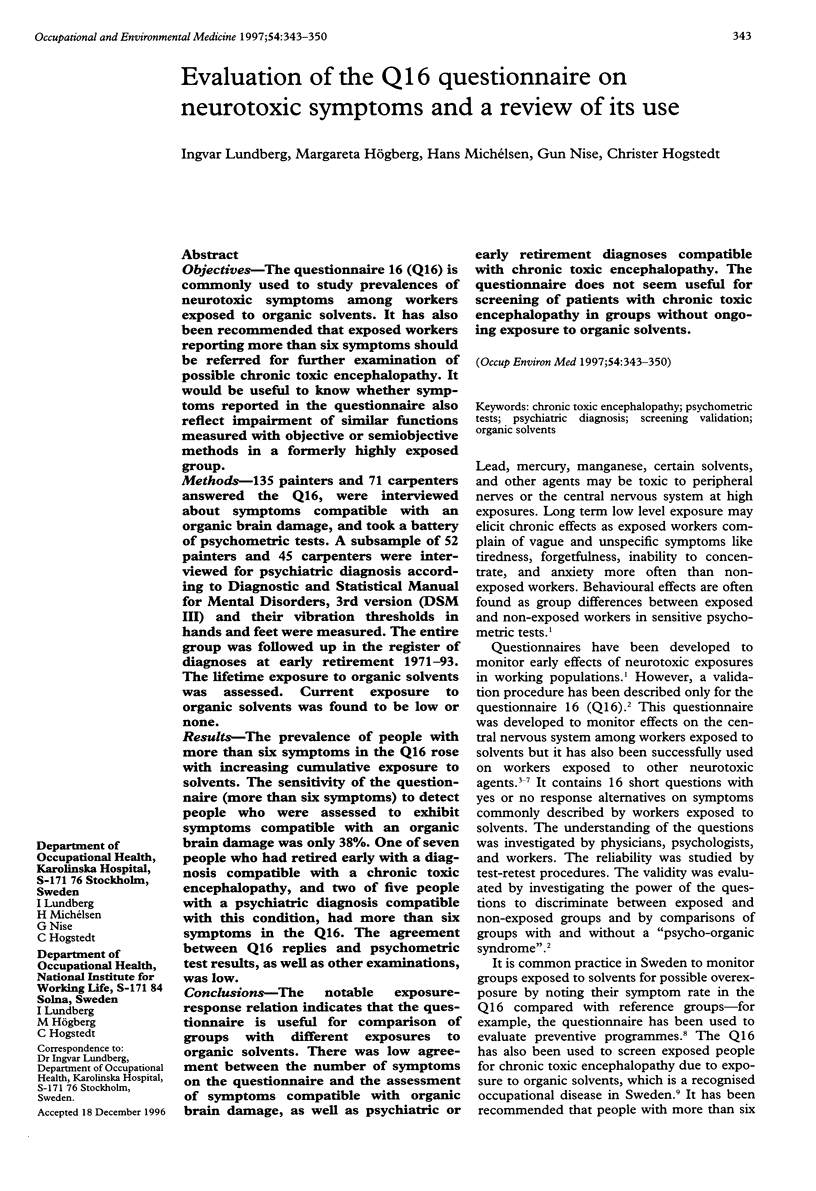
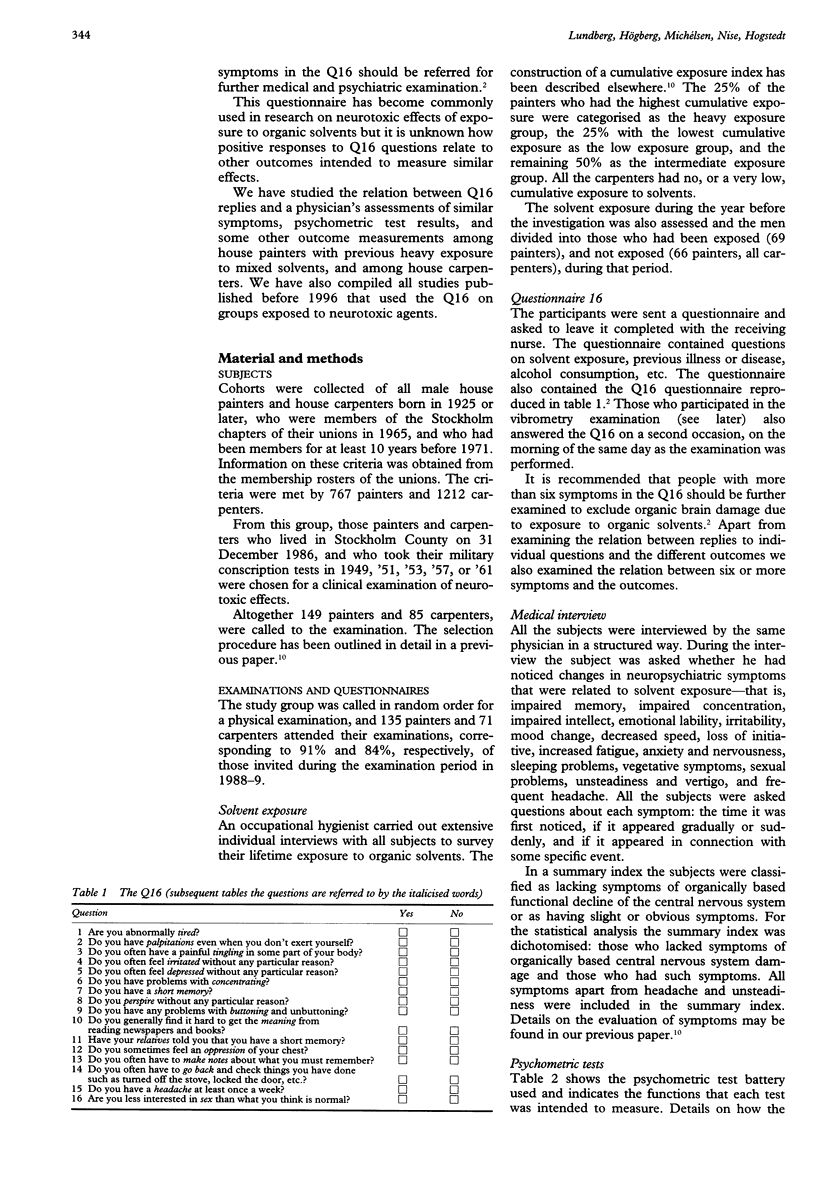
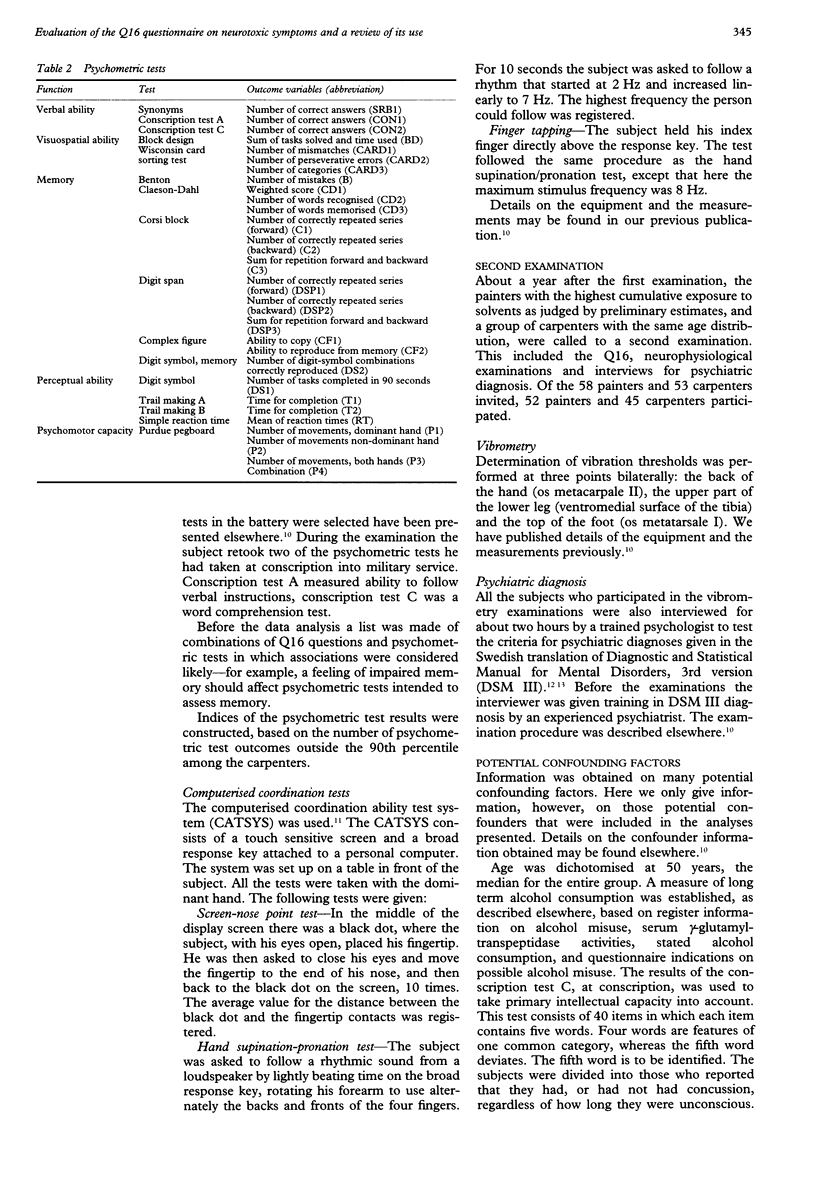
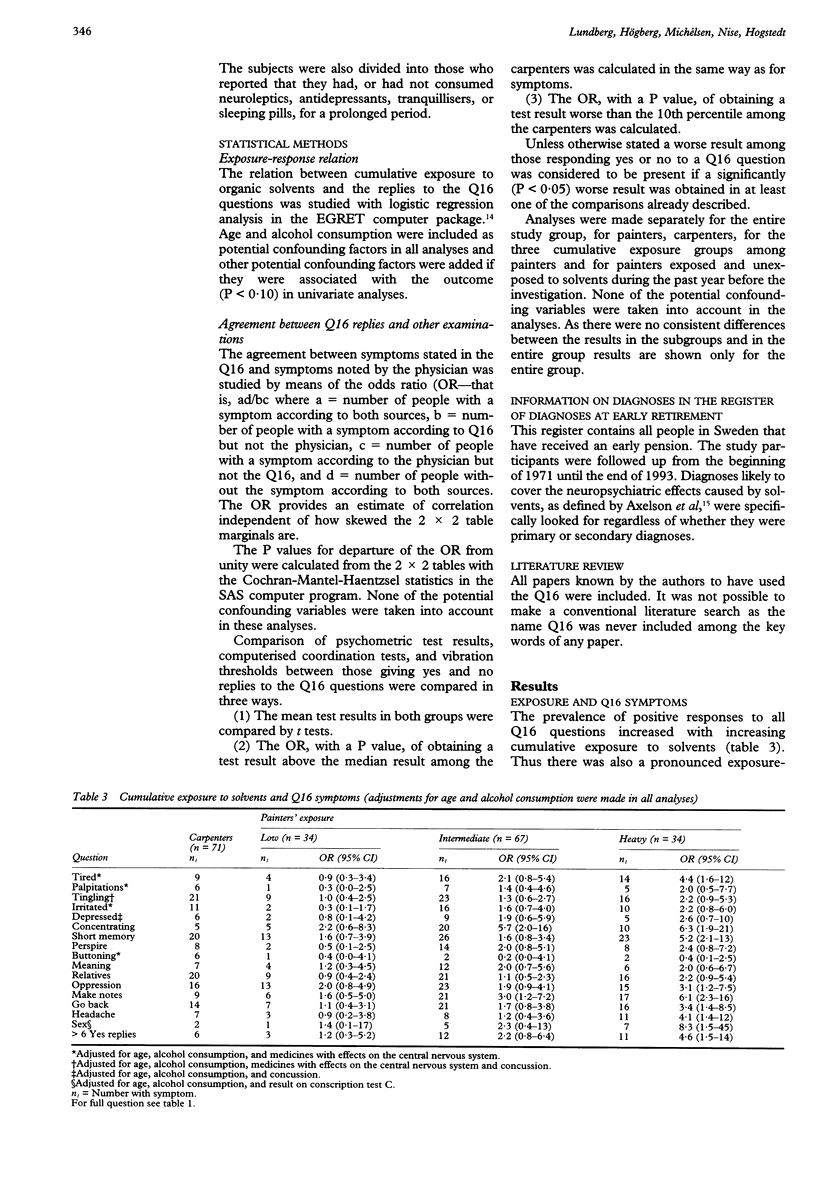
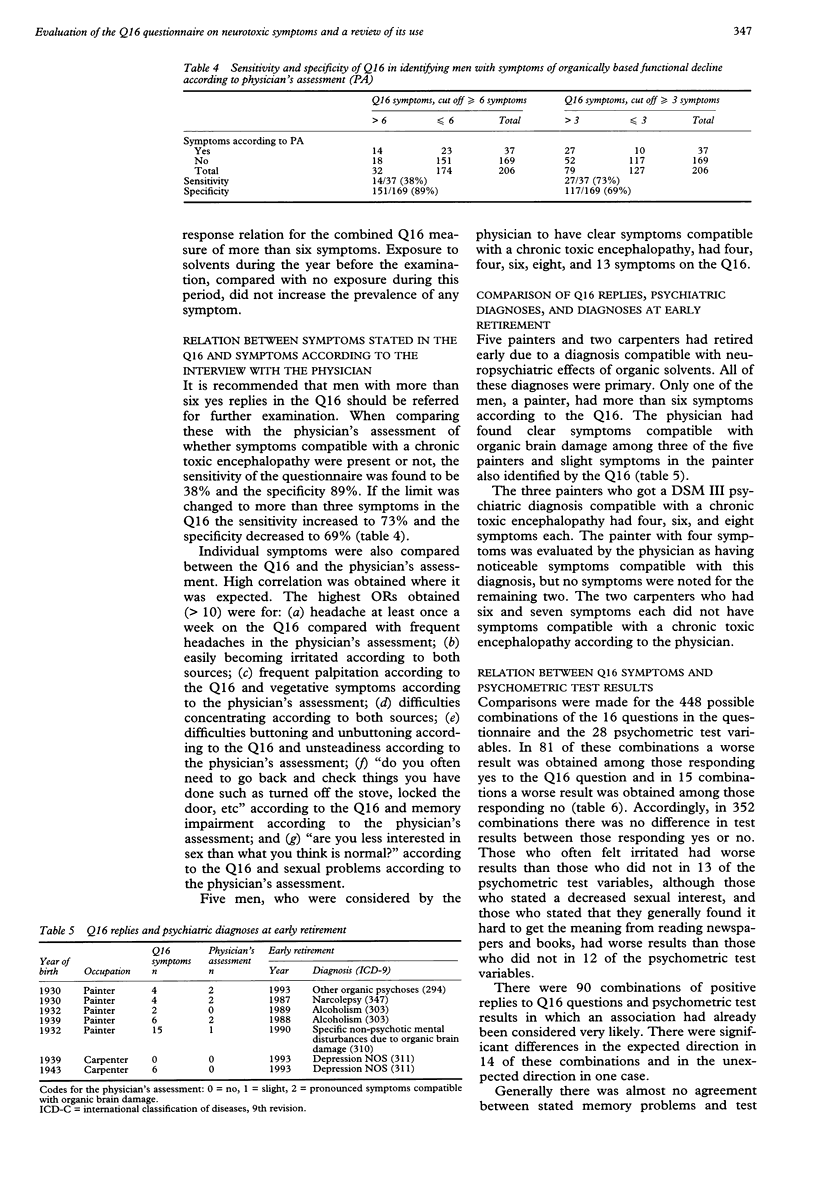
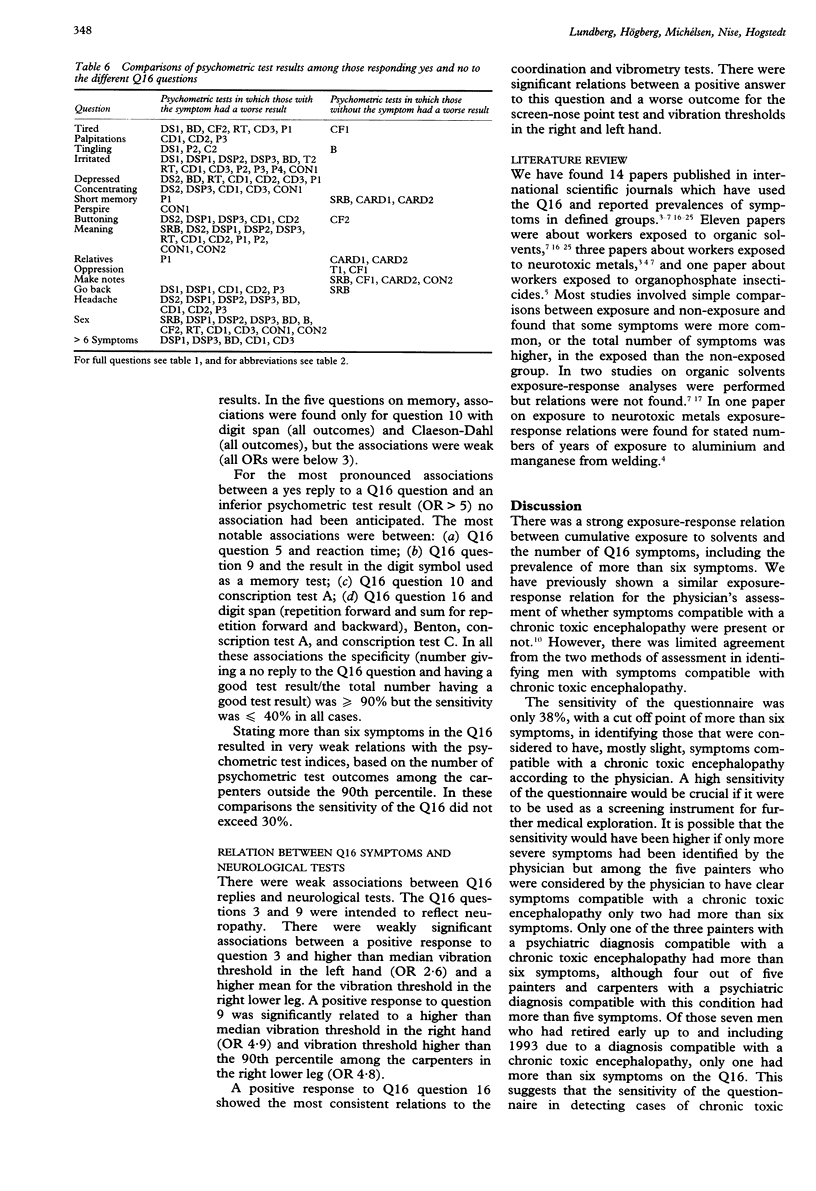
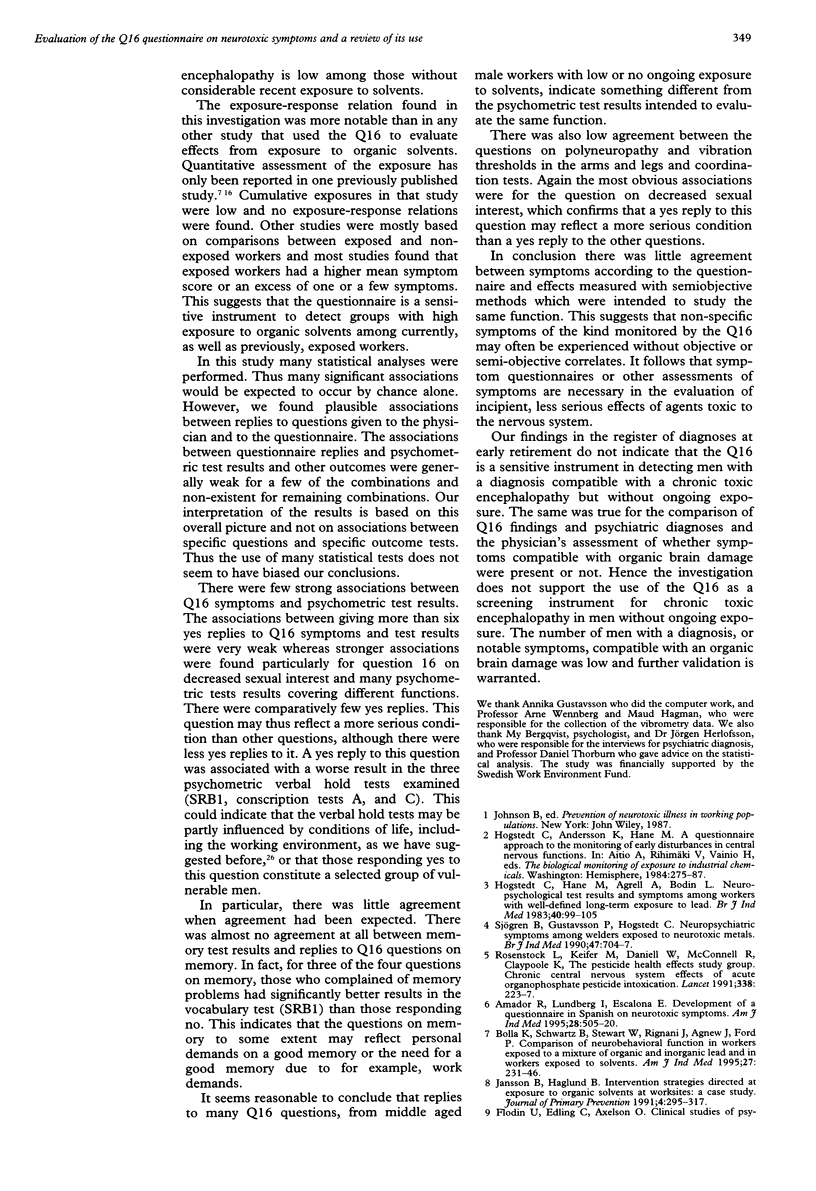

Selected References
These references are in PubMed. This may not be the complete list of references from this article.
- Anshelm Olson B. Effects of organic solvents on behavioral performance of workers in the paint industry. Neurobehav Toxicol Teratol. 1982 Nov-Dec;4(6):703–708. [PubMed] [Google Scholar]
- Axelson O., Hane M., Hogstedt C. A case-referent study on neuropsychiatric disorders among workers exposed to solvents. Scand J Work Environ Health. 1976 Mar;2(1):14–20. doi: 10.5271/sjweh.2826. [DOI] [PubMed] [Google Scholar]
- Bolla K. I., Schwartz B. S., Agnew J., Ford P. D., Bleecker M. L. Subclinical neuropsychiatric effects of chronic low-level solvent exposure in US paint manufacturers. J Occup Med. 1990 Aug;32(8):671–677. [PubMed] [Google Scholar]
- Bolla K. I., Schwartz B. S., Stewart W., Rignani J., Agnew J., Ford D. P. Comparison of neurobehavioral function in workers exposed to a mixture of organic and inorganic lead and in workers exposed to solvents. Am J Ind Med. 1995 Feb;27(2):231–246. doi: 10.1002/ajim.4700270208. [DOI] [PubMed] [Google Scholar]
- Cherry N., Hutchins H., Pace T., Waldron H. A. Neurobehavioural effects of repeated occupational exposure to toluene and paint solvents. Br J Ind Med. 1985 May;42(5):291–300. doi: 10.1136/oem.42.5.291. [DOI] [PMC free article] [PubMed] [Google Scholar]
- Edling C., Anundi H., Johanson G., Nilsson K. Increase in neuropsychiatric symptoms after occupational exposure to low levels of styrene. Br J Ind Med. 1993 Sep;50(9):843–850. doi: 10.1136/oem.50.9.843. [DOI] [PMC free article] [PubMed] [Google Scholar]
- Flodin U., Edling C., Axelson O. Clinical studies of psychoorganic syndromes among workers with exposure to solvents. Am J Ind Med. 1984;5(4):287–295. doi: 10.1002/ajim.4700050405. [DOI] [PubMed] [Google Scholar]
- Flodin U., Ekberg K., Andersson L. Neuropsychiatric effects of low exposure to styrene. Br J Ind Med. 1989 Nov;46(11):805–808. doi: 10.1136/oem.46.11.805. [DOI] [PMC free article] [PubMed] [Google Scholar]
- Gyntelberg F., Flarup M., Mikkelsen S., Palm T., Ryom C., Suadicani P. Computerized coordination ability testing. Acta Neurol Scand. 1990 Jul;82(1):39–42. doi: 10.1111/j.1600-0404.1990.tb01585.x. [DOI] [PubMed] [Google Scholar]
- Hogstedt C., Hane M., Agrell A., Bodin L. Neuropsychological test results and symptoms among workers with well-defined long-term exposure to lead. Br J Ind Med. 1983 Feb;40(1):99–105. doi: 10.1136/oem.40.1.99. [DOI] [PMC free article] [PubMed] [Google Scholar]
- Lundberg I., Michélsen H., Nise G., Hogstedt C., Högberg M., Alfredsson L., Almkvist O., Gustavsson A., Hagman M., Herlofson J. Neuropsychiatric function of housepainters with previous long-term heavy exposure to organic solvents. Scand J Work Environ Health. 1995;21 (Suppl 1):1–44. [PubMed] [Google Scholar]
- Michélsen H., Lundberg I. Neuropsychological verbal tests may lack "hold" properties in occupational studies of neurotoxic effects. Occup Environ Med. 1996 Jul;53(7):478–483. doi: 10.1136/oem.53.7.478. [DOI] [PMC free article] [PubMed] [Google Scholar]
- Ng T. P., Lim L. C., Win K. K. An investigation of solvent-induced neuro-psychiatric disorders in spray painters. Ann Acad Med Singapore. 1992 Nov;21(6):797–803. [PubMed] [Google Scholar]
- Ng T. P., Ong S. G., Lam W. K., Jones G. M. Neurobehavioural effects of industrial mixed solvent exposure in Chinese printing and paint workers. Neurotoxicol Teratol. 1990 Nov-Dec;12(6):661–664. doi: 10.1016/0892-0362(90)90082-n. [DOI] [PubMed] [Google Scholar]
- Rodezno R. A., Lundberg I., Escalona E. Development of a questionnaire in Spanish on neurotoxic symptoms. Am J Ind Med. 1995 Oct;28(4):505–520. doi: 10.1002/ajim.4700280407. [DOI] [PubMed] [Google Scholar]
- Rosenstock L., Keifer M., Daniell W. E., McConnell R., Claypoole K. Chronic central nervous system effects of acute organophosphate pesticide intoxication. The Pesticide Health Effects Study Group. Lancet. 1991 Jul 27;338(8761):223–227. doi: 10.1016/0140-6736(91)90356-t. [DOI] [PubMed] [Google Scholar]
- Sjögren B., Gustavsson P., Hogstedt C. Neuropsychiatric symptoms among welders exposed to neurotoxic metals. Br J Ind Med. 1990 Oct;47(10):704–707. doi: 10.1136/oem.47.10.704. [DOI] [PMC free article] [PubMed] [Google Scholar]
- Spurgeon A., Glass D. C., Calvert I. A., Cunningham-Hill M., Harrington J. M. Investigation of dose related neurobehavioural effects in paintmakers exposed to low levels of solvents. Occup Environ Med. 1994 Sep;51(9):626–630. doi: 10.1136/oem.51.9.626. [DOI] [PMC free article] [PubMed] [Google Scholar]
- Spurgeon A., Gray C. N., Sims J., Calvert I., Levy L. S., Harvey P. G., Harrington J. M. Neurobehavioral effects of long-term occupational exposure to organic solvents: two comparable studies. Am J Ind Med. 1992;22(3):325–335. doi: 10.1002/ajim.4700220306. [DOI] [PubMed] [Google Scholar]
- Triebig G., Schaller K. H., Weltle D. Neurotoxicity of solvent mixtures in spray painters. I. Study design, workplace exposure, and questionnaire. Int Arch Occup Environ Health. 1992;64(5):353–359. doi: 10.1007/BF00379546. [DOI] [PubMed] [Google Scholar]


